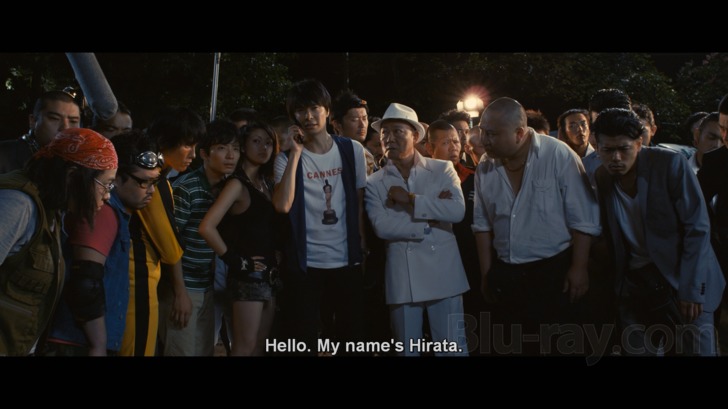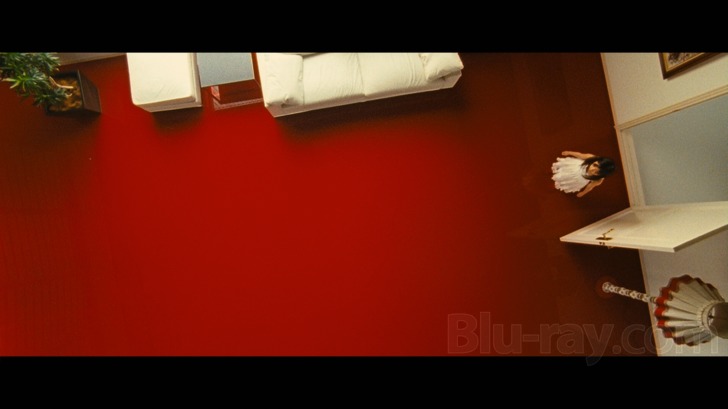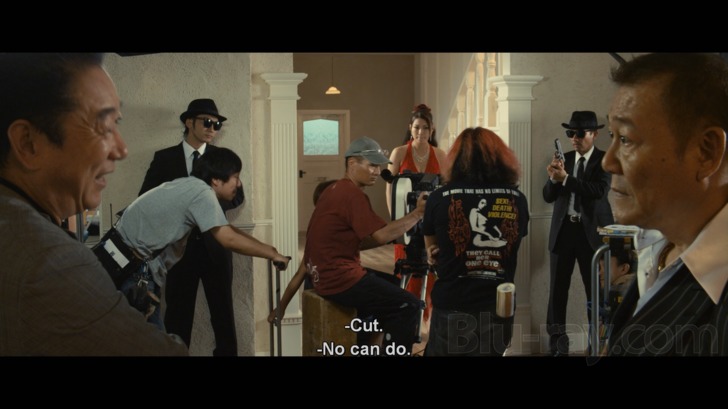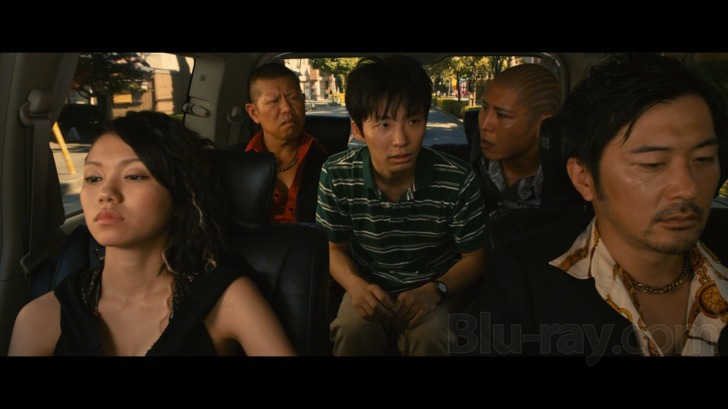Why Don't You Play in Hell? Blu-ray Movie
HomeWhy Don't You Play in Hell? Blu-ray Movie 
Jigoku de naze waruiDrafthouse Films | 2013 | 130 min | Not rated | Jan 27, 2015
Movie rating
7.4 | / 10 |
Blu-ray rating
| Users | 0.0 | |
| Reviewer | 3.5 | |
| Overall | 3.5 |
Overview
Why Don't You Play in Hell? (2013)
A renegade film crew becomes embroiled with a yakuza clan feud.
Starring: Tak Sakaguchi, Jun Kunimura, Fumi Nikaidô, Hiroki Hasegawa, Shin'ichi TsutsumiDirector: Sion Sono
| Foreign | Uncertain |
| Drama | Uncertain |
| Crime | Uncertain |
| Comedy | Uncertain |
| Action | Uncertain |
Specifications
Video
Video codec: MPEG-4 AVC
Video resolution: 1080p
Aspect ratio: 2.39:1
Original aspect ratio: 2.39:1
Audio
Japanese: DTS-HD Master Audio 5.1
Subtitles
English
Discs
50GB Blu-ray Disc
Single disc (1 BD)
Playback
Region A (locked)
Review
Rating summary
| Movie | 3.5 | |
| Video | 4.5 | |
| Audio | 4.0 | |
| Extras | 1.5 | |
| Overall | 3.5 |
Why Don't You Play in Hell? Blu-ray Movie Review
Cinema as Gang War (or Is It the Other Way Around?)
Reviewed by Michael Reuben January 27, 2015Drafthouse Films has become the patron saint of midnight movies and cult classics, and its latest release, Japanese writer/director Sion Sono's Why Don't You Play in Hell?, is a perfect addition to a collection that already contains The FP, Miami Connection, The Visitor and Ms. 45. Sono's blood-soaked tale of an amateur film crew shooting the most realistic yakuza epic ever made has frequently been described as "Tarantino-esque", but even America's most famous former video store clerk has never attempted anything so brazenly self-referential, where the film is about making a film that, in the end, may be impossible to complete because it's an open question whether anyone survives to finish it. Decide for yourself after watching. Sono wrote the script for Play in Hell at least fifteen years before making the film, and he loosely based the amateur filmmakers on the group of friends with whom he worked as a young man before his mainstream success with such works as Suicide Club (2001). According to Sono, the film's title refers to the low levels of the filmmaking pyramid, where budgets are small, critical acclaim is unlikely and awards are scant—but you get to keep your freedom. It's no doubt intentional that he flashes the title across the screen during a confrontation between the wannabe auteurs and a frustrated truck driver whose path they are blocking and who treats them as errant children interfering with adult business. "Kids should listen to their fathers!" he yells at them. "You aren't my father!" replies the ringleader, lobbing an egg at the windshield—and the film's title is superimposed over the yellow smear. Play in Hell is Sono's celebration of his apprenticeship in the "hell" of exploitation films, where independence serves as compensation for the lack of everything else.

The renegade film crew that races through Play in Hell has christened themselves "the F*** Bombers", a name that neatly sums up their attitude toward the world. (It is spelled out in the film.) The leader is Director Hirata, who is played as a teenager by Tatsuya Nakajima and as a young adult by Hiroki Hasegawa. In the film's opening sequence, the group begins filming a fistfight between street kids, which is how Hirata first meets Sasaki (Tak Sakaguchi), who he decides to reinvent as the Japanese Bruce Lee. For ten years, the F*** Bombers pursue their dream of making a movie, always shooting in 8mm, because that is all they can afford. Their mentor is an elderly projectionist, a Japanese version of Philippe Noiret's Alfredo in Cinema Paradiso. In the world of Play in Hell, movies are shot only on film. There isn't a video camera in sight. When the F*** Bombers finally graduate to the big time, it's 35mm (the phrase gets repeated so often that it becomes a joke: "35mm!!!"). Like the films that first inspired Sono and those he made when he was young, Play in Hell celebrates the magic of celluloid. The irony is that the celebration itself was shot digitally, because today that is the cheapest way for an independent filmmaker to rein in costs. While the young rebels are absorbed in their pursuits, a yakuza war is erupting between the Muto Clan, headed by Taizo Muto (Jun Kunimura), and the Kitigawa Clan, which will eventually be headed by Ikegami (Shin'ichi Tsutsumi). The causes are obscure, but in yakuza films is the cause ever truly important? A key factor is Muto's daughter, Mitsuko, a precocious child actor (played by Nanoka Hara) who has made a successful toothpaste commercial in which she sings a catchy jingle that people can't get out of their heads. It's heard as Play in Hell opens, and the lyrics sound like a parody (assuming the translation is accurate) as they encourage customers to "gnash" and "rasp" their teeth while brushing. But Mitsuko herself is a hit. A promising future awaits her, until the gang rivalry sends her life in another direction. The sequence in which everything begins to change contains the kind of memorably bloody imagery that only Japanese cinema could produce. Ten years later, Muto is determined to transform his daughter (now a young adult played by Fumi Nikaidô) into a film star, which is the dream of her mother (Tomochika). But Mitsuko Muto has lost any interest in fulfilling her parents' dreams. In her attempt to escape her father's clutches, she kidnaps a pretend boyfriend named Koji (Gen Hoshino) as a cover story, but Koji quickly falls in love with Mitsuko for real, as soon as he realizes that this is the girl whose image transfixed him before the TV when he was a small boy. Eventually Mitsuko strikes a bargain with her determined father. She will make the film he wants as long as Koji directs it. Koji, of course, has no idea how to make a movie, but chance (or is it the "god of movies" so often invoked throughout Play in Hell?) leads him to the F*** Bombers and Director Hatari, who immediately takes over the shoot. Engaging in shuttle diplomacy—some might call it a double cross—between the two warring crime clans, Hatari proceeds to arrange the bloodiest confrontation ever to be captured on film. And all of it will happen for real, even more so than Hatari plans. In the hands of a lesser storyteller, this maze of intersecting genres, plot lines and even acting styles wouldn't stand a chance, but Sono is a thoughtful craftsman who pays as much attention to narrative construction as he does to the stylistic excess of his major set pieces. Specific events are tucked into the story along the way so that they can pay off later when they're needed. There are no loose ends, even at the very end when Play in Hell suffers the usual fate of self-referential stories and turns into a snake swallowing its own tale (you'll know what I mean when you see it). Sono does enjoy toying with his viewers, letting them think that's he's lost control of the narrative by introducing a character or event that seems utterly disconnected from everything that's gone before. But he always rewinds to provide the necessary connections and reassure the audience that, "Yes, I know where we are and where we're going. Hang on!" Play in Hell is so lively, so frequently silly and so cheerfully violent that it will no doubt require many viewings to spot all the details that Sono has tucked into the corners of the frame. In the press conference included in the extras, Sono's friend and former collaborator, Tanobe, points out that Sasaki's Bruce Lee-like character spends most of the film in a yellow jumpsuit, but then, in a camera pan during the final battle sequence, is seen wearing Bruce Lee's classic black pants from Enter the Dragon. According to Tanobe, this represents Sono's "resurrection" of Bruce Lee, and he says it brings tears to his eyes. How many more such details are waiting to be discovered by alert viewers of Sono's intricate valentine to Japanese (and Hong Kong) exploitation cinema? To find out, you'll have to go play in hell for yourself.
Why Don't You Play in Hell? Blu-ray Movie, Video Quality 

Why Don't You Play in Hell? was shot by Hideo Yamamoto, whose work includes Ichi the Killer and other works for Takashi Miike, as well as the American remake of The Grudge. The film was shot on the Red Epic and finished on a digital intermediate, from which the digital master for Drafthouse's 1080p, AVC-encoded Blu-ray was presumably derived. Substantial CGI was used in post-production to extend and amplify the practical effects involving grievous injury, severed limbs, multiple decapitations and other effects that are best left for the viewer to discover. The footage from the earlier time period has been processed to add additional texture that might almost be mistaken for film grain, except for its distinctly digital appearance. For present-day scenes, which comprise the bulk of Play in Hell, the image retains the smooth surface typical of digitally acquired footage. Even with the artificial "aging" in the sequences set ten years ago, the Blu-ray image remains sharp, clear and detailed, which is important for a film containing numerous long shots with multiple characters, all engaged in different activities. The only time that detail suffers is when the frame shrinks to a 1.33:1 square in the center to simulate either the view through an 8mm viewfinder or the image on a TV. Colors are generally rich and intense, especially primaries such as the red of blood, the yellow of Sasaki's track suit, various blues throughout the frame. Black, and its various shades, are solid and well-rendered. Given the many kinetic scenes, violent and otherwise, in Play in Hell, including Sono's preferred scene transition of a rapid page turn, one can only be grateful that Drafthouse has mastered the disc with an average bitrate of 31.99 Mbps. Not only are there no artifacts, but the image quality remains consistently high throughout.
Why Don't You Play in Hell? Blu-ray Movie, Audio Quality 

Play in Hell's original Japanese 5.1 soundtrack is encoded on Blu-ray in lossless DTS-HD MA, with optional English subtitles. It's a lively mix to accompany the busy plot, and the sound effects often have that slightly unnatural quality that fans of martial arts films will immediately recognize, especially where sounds of violence are concerned (knife thrusts, sword clatters, even gunfire). The surrounds are used subtly but effectively to create an expansive sound field, and the cheerful score (composed by Sono himself) fills the room. The voices are clear and audible, but I have to defer to others on whether the dialogue is clear.
Why Don't You Play in Hell? Blu-ray Movie, Special Features and Extras 

- Press Conference Interview with Sion Sono (480i; 1.78:1, enhanced; 22:24): The date is not provided, but the conference is set in a Tower Records store (which still exists in Japan). Joined by an editor and publisher identified as Tanobe, whom Sono describes as an old friend and member of the original "F*** Bombers", Sono reminisces about the early adventures that inspired Play in Hell. The video appears to have been recorded on a cell phone and is of poor quality. In Japanese with English subtitles.
- Trailers
- Red Band Theatrical Trailer
- Green Band Theatrical Trailer
- Cheap Thrills
- The FP
- Miami Connection
- Pieta
- Booklet: As usual, Drafthouse has included a booklet with stills, plus film and disc credits. This one also has a short comment from James "Barf" Callahan on his design for the poster that Drafthouse commissioned for the film, followed by nine pages of reproductions tracing the poster's evolution.
- Poster: An 11"x17" reproduction of Callahan's poster is folded inside the Blu-ray case.
Why Don't You Play in Hell? Blu-ray Movie, Overall Score and Recommendation 

Why Don't You Play in Hell? isn't for everyone. It's aimed at martial arts genre junkies who are willing to laugh at themselves and their enthusiasm. Certainly no one is more the butt of Sono's humor than himself, as he paints a mocking self-portrait through the character of Hirata, the director who is more ruthless than any yakuza boss in sight, mercilessly setting one clan against the other for the sake of the best possible shots, then gleefully scooping up the blood-soaked film mags for the lab to develop. Hirata is the most savage maniac of the lot. Then again, maybe that's what it takes to survive in film "hell". I would have liked to see more extras about the making of the film, but the presentation is superb and the film is highly recommended for those who know what they're getting into.
Other editions
Why Don't You Play in Hell?: Other Editions
Similar titles
Similar titles you might also like

The Blind Swordsman: Zatoichi
座頭市, Zatōichi
2003

Beyond Outrage
アウトレイジ ビヨンド / Outrage Beyond
2012

Outrage
アウトレイジ / Way of the Yakuza
2010

Love Exposure
愛のむきだし / Ai no mukidashi
2008

A Bittersweet Life
2005

The Gangster, the Cop, the Devil
악인전 / Akinjeon
2019

Kills on Wheels
Tiszta szívvel
2016

Contraband
Luca il contrabbandiere | Standard Edition
1980

First Love
初恋 / Hatsukoi
2019

Drunken Angel
醉いどれ天使 / Yoidore tenshi
1948

Bullhead
Rundskop
2011

In Order of Disappearance
Kraftidioten
2014

Ash Is Purest White
江湖儿女
2018

Dragnet Girl
非常線の女
1933

Gangs of Wasseypur
2012

A Prophet
Un prophète
2009

The Big Racket
Il grande racket
1976

Running Out of Time
暗戰 / Am zin
1999

Triad Underworld
Gong wu
2004

Rulers of the City
I padroni della città
1976

